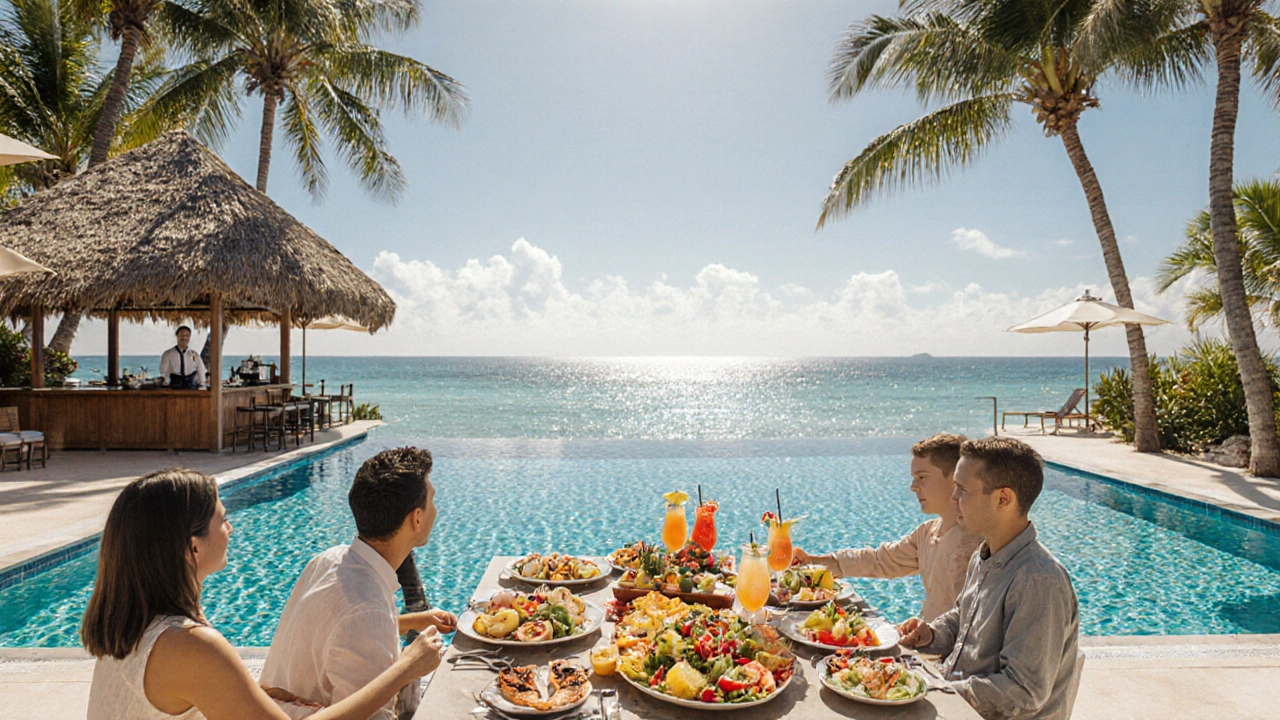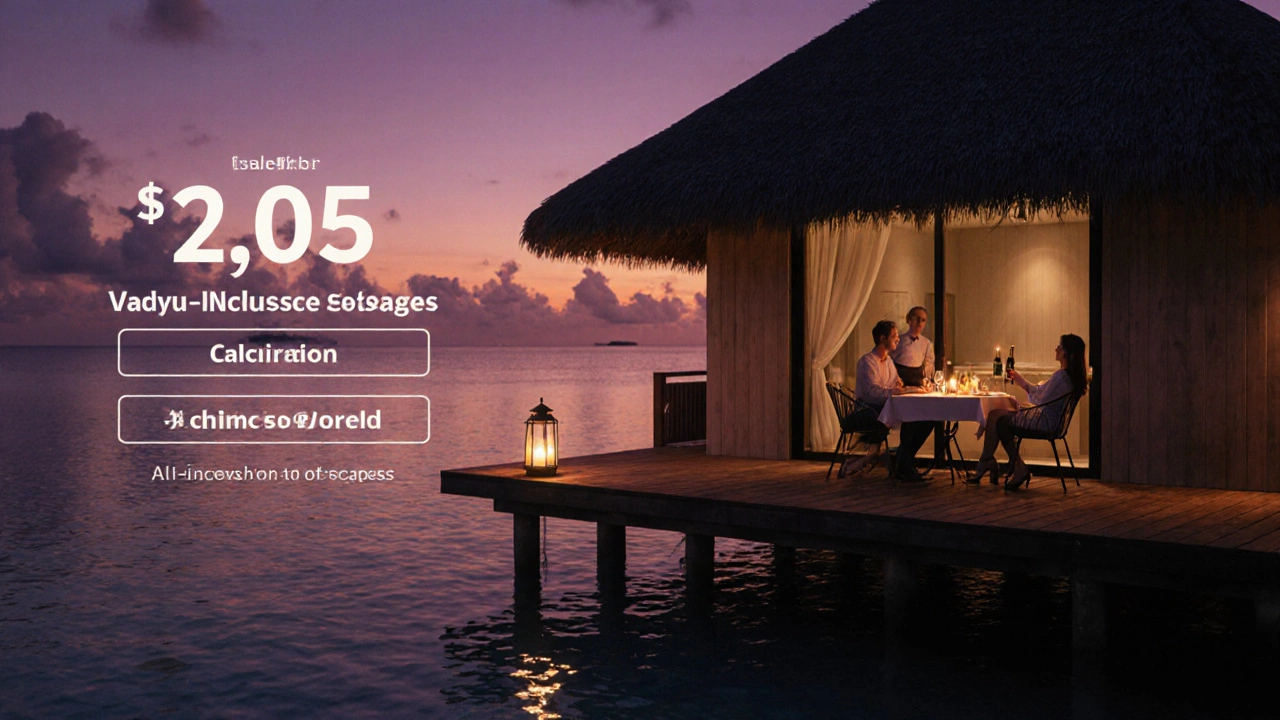Should You Book an All‑Inclusive Hotel? Pros, Cons & When It Pays Off
 Oct, 20 2025
Oct, 20 2025
All-Inclusive Hotel Cost Calculator
Calculate whether an all-inclusive hotel offers better value than paying for meals, drinks, and activities separately based on your travel details.
Cost Comparison
| Category | All-Inclusive | À La Carte | Comparison |
|---|---|---|---|
| Accommodation | $0 | ||
| Food | $0 | ||
| Drinks | $0 | ||
| Activities | $0 | ||
| Total |
Recommendation criteria: All-inclusive is worth it if it saves at least 20% compared to à la carte pricing.
Key Takeaways
- All‑inclusive hotels bundle lodging, meals, drinks and many activities into one upfront price.
- They shine for families, groups, and travelers heading to destinations where outside dining is pricey.
- Hidden fees, limited dining choices, and lower flexibility can turn the deal sour if you’re not careful.
- Do the math: compare the all‑inclusive price to your expected spend on food, drinks and activities.
- Look for reputable brands, transparent policies and seasonal discounts to maximise value.
When you see a glossy brochure promising endless buffets, cocktail hours and beachside activities, the question that pops into most travelers’ heads is: all-inclusive hotels worth the money? The answer isn’t a simple yes or no - it depends on your budget, travel style and the destination you’re eyeing. In this guide we break down how the all‑inclusive model works, weigh the benefits against the drawbacks, and give you a step‑by‑step way to decide if it’s the right fit for your next trip.
What Exactly Is an All‑Inclusive Hotel?
All‑inclusive hotel is a type of accommodation that bundles room rates with meals, beverages (including alcohol), and often a range of on‑site activities into a single price. The idea dates back to the 1950s luxury resorts in the Caribbean, where operators wanted to simplify the travel experience for tourists from the United States and Europe. Today the concept has spread to Mexico, the Maldives, the Middle East and even some European ski resorts.
Many travelers conflate all‑inclusive resort with an all‑inclusive hotel, but there’s a subtle difference. Resorts usually sit on larger plots of land, offering extensive facilities like multiple pools, golf courses and sprawling beaches, while hotels may be smaller, city‑center properties that still provide the same bundled services.
How Pricing Works: What’s Inside the Package?
Understanding what you actually pay for is key to judging value. Most packages include:
- Accommodation - standard or upgraded rooms, sometimes with ocean views.
- Meal plan - three meals a day at on‑site restaurants, plus snacks.
- Beverage package - soft drinks, bottled water, coffee, tea, and often unlimited alcoholic drinks.
- Resort amenities - pool access, fitness centre, kids’ club, nightly entertainment, sometimes water sports.
- Taxes and service charges - usually included, but always double‑check the fine print.
What’s *not* usually covered?
- Premium dining (à la carte restaurants, specialty cuisines).
- Excursions off the property - think snorkeling trips, city tours or zip‑lining.
- Airport transfers, unless explicitly stated.
- Mini‑bar items, spa treatments and high‑end alcoholic brands.
These exclusions can quickly add up if you plan to explore beyond the resort grounds.
Pros: When an All‑Inclusive Deal Shines
1. Budget predictability - You know the total cost before you even step foot on the beach. No surprise lunch bills or bar tabs.
2. Convenience for families - Kids can snack all day, parents don’t have to chase down restaurants, and most resorts provide kids’ clubs, babysitting and family‑friendly pools.
3. Value in high‑cost destinations - In places like the Caribbean, the Maldives or Dubai, dining out can be prohibitively expensive. Bundling everything can shave off 30‑50% of your expected spend.
4. All‑day activity access - From beach volleyball to yoga classes, you can try many activities without extra fees, which encourages a more active vacation.
5. Social atmosphere - Shared dining tables and communal lounges make it easy to meet fellow travelers, especially if you’re traveling solo.
Cons: Hidden Pitfalls to Watch
1. Limited culinary diversity - Buffet rotation can become repetitive after a few days. Specialty restaurants often cost extra.
2. Potential for over‑consumption - Unlimited drinks sound great, but the open‑bar model can lead to higher calorie intake and next‑day hangovers, especially if you’re not a heavy drinker.
3. Hidden fees - Some resorts charge for premium liquors, off‑site tours, or even for Wi‑Fi. Always read the fine print.
4. Less flexibility - If you prefer to explore local eateries or nightlife, the all‑inclusive setup can feel restrictive.
5. Quality variance - Not all all‑inclusive brands deliver the same level of service. Budget chains may skimp on food quality and housekeeping.
When It Makes Sense: Matching the Model to Your Travel Goals
If you’re traveling with kids, a large group, or on a limited vacation budget, the bundled price often wins. Here are three scenarios where an all‑inclusive stay typically pays off:
- Family beach vacation - Think 7‑day stay in Cancun with kids aged 5‑12. The combined cost of meals, drinks and kids’ club activities can be 40% cheaper than paying piecemeal.
- All‑season ski resort - In places like Whistler or the Austrian Alps, lift tickets and heated lounge access are sometimes bundled, cutting total spend.
- Luxury couples retreat - High‑end resorts in the Maldives often include spa credits, private dinner on the beach, and unlimited premium drinks, turning an otherwise extravagant bill into a manageable package.
Conversely, if you love hunting out local food markets, exploring city nightlife, or you’re traveling solo with a flexible schedule, an à la carte approach may give you more freedom and sometimes lower cost.
Hidden Costs: The Fine Print That Can Spoil the Deal
Even the most transparent resorts can have sneaky add‑ons. Keep an eye on:
- Premium liquor surcharge - Some brands label top‑shelf spirits as “premium” and charge a per‑drink fee.
- Excursion fees - A beachfront snorkel trip might be $30‑$50 per person, un‑included in the base price.
- Wi‑Fi access - Free Wi‑Fi is rare; many resorts charge $10‑$15 per day.
- Resort taxes - Local tourism taxes can add 10‑15% on top of the quoted rate.
- Early‑check‑in/late‑check‑out - If you need flexibility, expect a $30‑$50 surcharge.
Ask the front desk for a complete list of exclusions before you book. A clear answer saves you from surprise receipts later.
Tips to Get the Best Value
- Book during off‑peak months - Prices drop 20‑30% in shoulder seasons (e.g., late spring in the Caribbean).
- Look for promotions that include free airport transfers or resort credits.
- Choose brands with strong guest reviews on food quality - read recent TripAdvisor comments.
- Consider a mixed‑stay - spend a few nights in an all‑inclusive resort, then venture out for a local hotel or Airbnb.
- Ask about “all‑inclusive plus” packages that bundle premium drinks or specialty dining without extra fees.

All‑Inclusive vs. À La Carte: Quick Comparison
| Feature | All‑Inclusive | À La Carte |
|---|---|---|
| Meal Cost Predictability | Included (buffet + select restaurants) | Pay per meal; can vary widely |
| Drink Options | Unlimited soft drinks, house wines, some spirits | Pay per drink; premium bottles cost extra |
| Activity Access | On‑site pools, entertainment, basic water sports | Often pay per‑activity or tour |
| Flexibility | Limited to resort‑based dining/activities | Full freedom to explore local venues |
| Typical Savings | 30‑50% vs. expected off‑resort spend | Depends on personal choices |
Real‑World Example: A Family Trip to Punta Cana
Imagine a family of four booking a 7‑night stay at a mid‑range resort in Punta Cana for $2,200 total. The package includes:
- Standard room with sea view.
- All meals and unlimited drinks.
- Kids' club, pool, beach volleyball.
What would the same family spend if they chose a standard hotel and ate out?
- Room: $1,200 ($170/night).
- Meals (breakfast, lunch, dinner at local eateries): $120 per day × 7 = $840.
- Drinks (soft drinks, occasional cocktail): $30 per day × 7 = $210.
- Activities (snorkel tour, zip‑line): $150 per person × 4 = $600.
Total expected cost ≈ $2,850 - about $650 more than the all‑inclusive deal, not counting taxes and tips. In this case, the bundle clearly wins.
Bottom Line: How to Decide
Use this quick decision tree:
- Do you plan to spend most of your time on‑site? If yes, lean toward all‑inclusive.
- Is dining out a priority? If yes, à la carte may suit you better.
- Is your budget tight? Calculate expected daily spend and compare to the all‑inclusive price.
- Do you need flexibility for off‑resort adventures? Check the resort’s excursion fees.
If you answer “yes” to the first two questions and the math shows a savings of at least 20%, an all‑inclusive stay is likely worth it.
Frequently Asked Questions
Are all‑inclusive resorts always more expensive than regular hotels?
Not necessarily. In high‑cost destinations, the bundled price can be cheaper because meals, drinks and activities are pricey when bought separately. Always run a cost comparison based on your expected consumption.
Can I bring my own alcohol to an all‑inclusive hotel?
Most resorts have a strict no‑outside‑alcohol policy. Violating it can lead to fines or removal from the property.
Do children eat and drink for free?
Most all‑inclusive deals include kids’ meals and non‑alcoholic drinks, but some premium items (e.g., premium smoothies) may carry a small charge.
Is Wi‑Fi usually included?
Free Wi‑Fi is becoming more common, but many resorts still charge a daily fee. Ask ahead if it’s essential for you.
How far in advance should I book to get the best rate?
Booking 4‑6 months ahead for peak season usually secures the lowest prices. For shoulder season, a 2‑month window can be enough.
Now you’ve got the full picture. Whether you decide to go all‑in or not, the key is to line up the cost, the experience you want, and any hidden fees before you click ‘book.’ Happy travels!